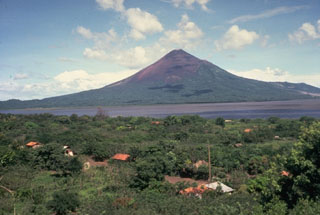Report on Momotombo (Nicaragua) — July 1994
Bulletin of the Global Volcanism Network, vol. 19, no. 7 (July 1994)
Managing Editor: Richard Wunderman.
Momotombo (Nicaragua) Summit fumarole temperatures range from 238 to 655°C
Please cite this report as:
Global Volcanism Program, 1994. Report on Momotombo (Nicaragua) (Wunderman, R., ed.). Bulletin of the Global Volcanism Network, 19:7. Smithsonian Institution. https://doi.org/10.5479/si.GVP.BGVN199407-344090
Momotombo
Nicaragua
12.423°N, 86.539°W; summit elev. 1270 m
All times are local (unless otherwise noted)
Beginning on 11 June, scientists from FIU and INETER deployed a datalogger in the crater to continuously monitor fumarole temperatures and barometric pressure. The team entered the summit crater three times along a trail that crosses an active avalanche chute and leads around to the NE crater rim. Condensate and Giggenbach-type samples were collected from fumaroles along the SW crater wall. These fumaroles were very corrosive, as indicated by the destruction of the datalogger thermocouples, and had temperatures ranging from 238 to 655°C. A voluminous plume was rising from the crater on 13 March.
Geological Summary. Momotombo is a young stratovolcano that rises prominently above the NW shore of Lake Managua, forming one of Nicaragua's most familiar landmarks. Momotombo began growing about 4500 years ago at the SE end of the Marrabios Range and consists of a somma from an older edifice that is surmounted by a symmetrical younger cone with a 150 x 250 m wide summit crater. Young lava flows extend down the NW flank into the 4-km-wide Monte Galán caldera. The youthful cone of Momotombito forms an island offshore in Lake Managua. Momotombo has a long record of Strombolian eruptions, punctuated by occasional stronger explosive activity. The latest eruption, in 1905, produced a lava flow that traveled from the summit to the lower NE base. A small black plume was seen above the crater after a 10 April 1996 earthquake, but later observations noted no significant changes in the crater. A major geothermal field is located on the south flank.
Information Contacts: Peter C. La Femina, Michael Conway, and Andrew MacFarlane, FIU; Christian Lugo M., INETER.

